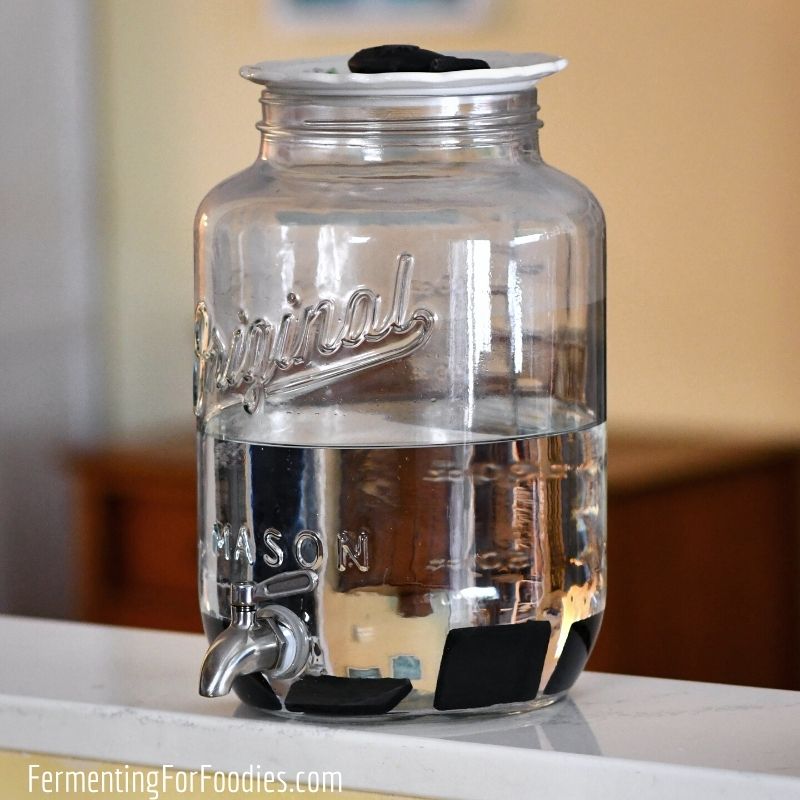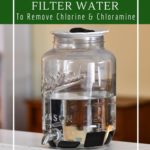Removing chlorine and chloramine from water is good for gut health and general well-being. It is also important for fermentation. Here’s the best way to filter water for clean drinking and fermenting.

Water is a subject that is near and dear to my heart for the following reasons:
- I live in an urban center, and my city water source is treated with chloramine. Chloramine is very stable and isn’t removed by most water filters.
- Chlorinated drinking water may affect our intestinal microbiome, particularly for babies and young children who are more susceptible to disturbances in gut health.
- I’m an avid fermenter, and I use tap water for most of my ferments.
Are you interested in learning how to filter water? Read on!
The goal of urban water treatment
No one wants to hear that their water source was contaminated with E. Coli, parasites, or other nasty microorganisms. So urban water is generally filtered and treated to prevent the spread of disease.
The best way to ensure that the water is sanitized from the source right through to your kitchen tap is to add chlorine or chloramine. These chemicals are both very effective at killing bacteria and parasites.
Issues with chlorinated and chloraminated water
While it is great to have access to clean and safe drinking water, it is not particularly good for our gut health or fermenting. Here are a few reasons why you might want to filter your water:
- Using chlorinated water for fermentation will slow or prevent the growth of lactobacteria and yeasts.
- Chlorine needs to be removed before filling a fish tank, because it can harm the fish.
- Chlorine-free water tastes better (and may be better for our gut health).
Chlorinated water versus chloraminated water
It’s really important to know whether your water is treated with chlorine or chloramine. It will make a big difference in how you filter your water.
Chlorinated Water
This is probably what you think you have… however, many cities are switching to the much more stable chloramine for water treatment.
Chlorine is easy to remove:
- It evaporates within 12 hours of sitting out on your kitchen counter.
- Boils away in 20 minutes.
- Chlorine is removed by most water filters.
So if you have chlorinated water then rejoice! Your off-the-shelf Brita filter is good enough. Or better yet, simply buy yourself a few glass pitchers and leave your water out on the counter overnight.
Chloraminated Water
Chloramine is a combination of chlorine and ammonia. It is a VERY stable disinfectant.
Unfortunately, it takes 2-3 days for chloramine to dissipate at room temperature, and nearly 2 hours to boil away. And unlike chlorine, most pass-through water filters won’t get rid of chloramine.
Don’t worry, all is not lost! Here’s how to dechloraminate your water:
- Throw a few slices of lemon or orange into your water. Citric acid breaks down ammonia in an hour or two.
- Use a submerged activated charcoal filter. (This is what I use. See photo at top of the post).
- There are a few other methods to remove chloramine. They mostly involve adding extra chemicals or UV light treatment. These aren’t practical for the average urbanite, so I recommend trying one of the above!
Bottled Water
Unless your tap water is unsafe for drinking, I don’t recommend using bottled water for fermenting. Not only does it contribute to plastic pollution, but it’s not always a chlorine-free solution.
In fact, most bottled water is just municipal tap water.


I thought that mixing chlorine and ammonia created a poisonous vapor. They must stabilize it somehow. Still, sounds pretty toxic.
There is a bit of chemistry involved… but that doesn’t make it nice to drink!
Hello Emillie, Just came across your website – really great to have so many good tips in one place. Thank you!
I’ve looked at charcoal filters you recommended, but they have paused their business for time being. Do you know other reliable suppliers of such/similar filters?
Thank you!
Thanks for reading! It is hard to find things right now… where are you located? You could try kishu: https://kishucharcoal.com/ Cheers!
so helpful!!! Thank you Emillie, i just found your site today and know I will be loving it!
Thanks!
Does bottled water like you buy at walmart have chlorine in it?
There are lots of different brands of bottled water. Some of them are just municipal tap water (like Dasani and Aquafina), some have added chlorine (Dasani), some are filtered. As long as your city/town/well is safe to drink, then it is probably just as clean, safe and pure as bottled water.
What about bottled distilled water? Could it have chlorine, chloramine, or ammonia? Am I OK drinking it if I use pink Himalayan salt to get trace minerals?
True distilled water doesn’t contain any minerals. It’s fine fermenting, but probably not necessary for drinking unless you don’t have access to safe drinking water. It’s also missing all sorts of minerals, like calcium and magnesium. Cheers!
Interesting! I have always just used tap water for fermenting, but your post makes me wonder if I’m missing out by not trying to get rid of the chloramine. Assuming you need to leave the water in a jug with no covering, to allow for the ammonia to evaporate once you’ve put the lemon slice in it?
Hi Jessica,
I know a few people who use our water for kombucha and fermenting. If you’re not having a problem with it, then it’s fine. 🙂 However, some areas of the CRD (like the Gulf Islands) have VERY high chlorine. So high that most residents don’t drink it because of the flavor. And I do recommend that they let the chlorine (in their case) evaporate.
If you are having digestion issues, then you may want to remove the chloramine from your drinking water. You only need to leave the water out for 2 hours with the lemon slices.
Be well, Emillie